Ijraset Journal For Research in Applied Science and Engineering Technology
- Home / Ijraset
- On This Page
- Abstract
- Introduction
- Conclusion
- References
- Copyright
Formulation and Evaluation of Face Scrub from Aegle Marvelous Fruit
Authors: Anjali Chaudhari, Amit Chaudhari
DOI Link: https://doi.org/10.22214/ijraset.2024.61677
Certificate: View Certificate
Abstract
Scrub is defined as the products used for the purpose of beautifying, cleansing, promoting attractiveness or alternating the appearance. The aim of study is to and revives on application use of Beal fruit in preparation of face scrub as an active ingredient. Scrub is use For the purpose of enhancing skin beauty, several skin conditions are developed, such as skin protection, sunscreen, anti-acne, and anti-wrinkle products. Despite the enormous health benefits of synthetic substances, which once more cause environmental destruction, demand for herbal items and cosmetics is r rising daily. Due to their dual functionality as medications and cosmetics, natural cosmetics are in high demand nowadays. A facial scrub is a cosmetic or a beauty product used to exfoliate and clean the skin on the face and body. Blackheads, whiteheads, sebum, and skin cells can all be removed by using face scrubs. In this face scrub, Cosmetics eagle marvelous is used as an active ingredient. The other ingredients like sugar, honey, carpool, Methyl paraben, distilled water, Propylene glycol, sodium lauryl sulPhate, triethanolamine. The prepared scrub is evaluated for the various parameters such as appearance, PH, viscosity, spread ability, wash ability, irritability and found to be satisfied with all required characterizations. Thus, the developed formulation can be used as an effective scrub for healthy and glowing skin.
Introduction
I. INTRODUCTION
Cosmetics encompass products used for cleansing, beautifying, and enhancing appearance. Historically, herbs have been integral in this realm. Skin, particularly facial skin, reflects overall health. Scrubs, categorized as facial or body, aid in exfoliation. Facial scrubs, richer in oil, are gentler, removing dead cells and promoting skin renewal. Essential oils vary based on skin type: dry, oily, or sensitive. Regular use results in smoother, glowing skin. Mild abrasives are key, applied directly or with pads, accompanied by gentle massage to enhance blood circulation and oxygen supply. [1-5].
Skin, the body's largest organ, acts as a protective barrier against environmental threats. Regular cleansing is crucial to remove impurities and promote healthy skin appearance. Exfoliation, achieved through chemical or mechanical means, removes dead cells, leading to smoother and healthier skin. Facial scrubs, containing natural or synthetic particles, deeply cleanse and exfoliate, enhancing radiance and softness. They aid in clearing pores, improving suppleness, and accelerating cell turnover. Gently massaging the scrub promotes blood circulation and oxygenation. Herbal exfoliants reduce ageing effects and environmental damage. Facial scrubs address various skin issues, including dullness, wrinkles, and dark spots. Suitable for all skin types, they effectively remove excess oil and dirt, leaving skin refreshed and revitalized. Incorporating facial scrubs into skincare routines aids in gentle exfoliation and rejuvenation, promoting a youthful complexion. [6-15]
II. ABOUT SCRUB
Exfoliating scrub lessens aging-related changes and counteracts the effects of the environment by removing dead skin cells from the surface and promoting the growth of cells in the sub-epidermal layer Technically, removing these dead skin cells from the surface involves using a scrub or herbal remedies that have anti-aging, vitamin, antioxidant, and antibacterial properties that help deep clean the skin, make it shine, and make it look attractive.[16] It was easy to apply a facial scrub: just pick one that was right for your skin type, rub it in for a minute on hydrated skin, and then wash it off.[17] There is a scrub for every type of skin. Only the essential oil used as an ingredient in the scrub will change depending on the skin type. Three distinct skin types are sensitive, oily, and dry. [18]
A. Ideal properties scrub [19]
- It should be non-sticky and mild abrasive.
- It should be Non-toxic.
- It must remove dirt and dead skin.
- It should Non-irritant.
- It must contain small gritty particles.
B. Merits of scrub [20]:
- Exfoliation reveals clean skin by scrubbing away dirt and sweat from pores.
- Exfoliation eliminates skin flakes caused by the accumulation of dead cells.
- Exfoliation enhances skin shine, making it appear more radiant.
- Exfoliation helps remove dead cells, preventing skin from looking dull and weary.
- Exfoliation aids in the removal of acne scars.
- Exfoliation promotes smooth skin texture, making it soft and well-nourished.
- A good scrub improves skin's cleanliness, smoothness, and overall texture.
C. Demerits of Scrub: [21]
- Over-scrubbing can leave pores open, exposing skin to UV radiation and pollution, increasing vulnerability to infections and tanning.
- Skin irritation, including redness and inflammation, can be brought on by harsh rubbing movements and chemicals.
III. SELECTION OF SCRUB BASED ON SKIN TYPE
- Oily Skin: Use a face scrub with salicylic acid to unclog pores and fight acne.
- Dry Skin: Face scrub containing glycolic acid to remove dead skin cells and hydrate dry skin.
- Sensitive Skin: Choose a gentle face scrub with antibacterial and anti-inflammatory properties, such as one containing propylene glycol, yogurt, turmeric, or sugar.
- Combination Skin: Use a facial scrub that removes excess oil without drying out the skin, recommended by specialists.
A. Steps To Use a Scrub: [23]
Step 1: Rinse your face with water thoroughly. Do not pat it dry. Step 2: Take a nickel - sized amount of facial scrub in your palm. Step 3: Apply the facial scrub on your wet face.
Step 4: Gently rub the scrub on your face, applying the least amount of pressure. You can rub the scrub in a circular motion using your fingers.
Step 5: Always massage your face upwards and focus on areas like the top and corner of your nose, cheeks and upper lips.
Step 6: Continue the massage for 10 to 15 seconds.
Step 7: Now move to your neck and under the chin and massage for another 10 seconds.
Step 8: Once you finish exfoliating, wash your face with cold or lukewarm water.
Step 9: Gently pat your face dry using a soft towel.
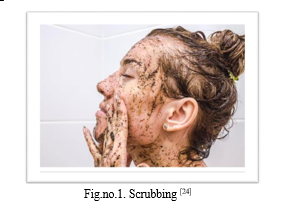
IV. MAIN HERBS USED IN PREPARATION OF SCRUB
Aegle marvelous:
Synonyms: Green Apple, Golden Apple, Aegle Marvelous, wood apple, Beal fruit. [25]
A. Basic Information about Aegle marvelous
The Indian medicinal plant known as bale has been traditionally used for various ailments. A. marvels, native to Northern India, is also found across the Indian Peninsula and neighboring regions. It's a slow-growing tree with spiky branches, thick bark, and a sweet yet unpleasant- tasting gum-like substance. Biologically active chemicals and essential oils are extracted from bale plants, with selective solvents and standard procedures applied to the most active parts of the plant. Taxonomical classification of A. marvels is provided in Table 1. [26-31]
B. Benefits of Beal Fruit extract for Hair:[32]
- Helps in moisturizing the scalp.
- Helps in getting rid of Dandruff, Itchy Scalp, etc.:
- Promotes Hair Growth:
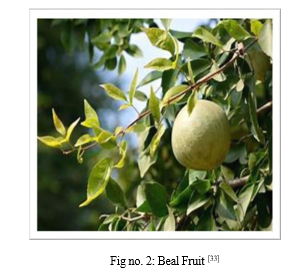
Table no. 1
Taxonomical classification [34]
|
Kingdom Plantae |
|
Sub-kingdom Tracheobionta |
|
Super division SpermatoPhyte |
|
Division MagnolioPhyte |
|
Class Magnoliopsida |
|
Subclass Residue |
|
Order Spindale’s |
|
Family Rutaceous |
|
Genus Aegle |
|
Species Marvelous |
|
Chemical Composition Alkaloids , Aegeline , Coumarins , Cineol , CaryoPhyllene |
Table 2
Ethno medicinal uses of Aegle marvelous [35]
|
Parts Uses |
|
Leaves The leaves are most effective in treating fever, nausea, vomiting, swellings, dysentery, dyspepsia, seminal weakness, and intermittent fever. |
|
Root The roots of bale are thought to be effective in treating urinary problems, preventing heart palpitations, and curing fevers. They are also said to relieve abdominal pain. The medical properties of Dash amula lie in its root to treat fever, diarrhea, and flatulence. |
|
Bark The villagers use a decoction of the bark to treat fever and cough. |
|
Flower An anti-dysenteric, ant diabetic, diaPhoretic, and local anesthetic medication can be produced by distilling flowers. It is utilized as a tonic for the stomach and intestine. |
|
Fruit Beal fruits are edible. The pulp used to make delicious items like murabba, puddings, and juice. Apart from their laxative use and curing respiratory ailments, also used in several traditional medications to treat chronic diarrhea, peptic ulcers, inhibit lipid peroxidation, free radicals scavenging, antioxidants, anti-ulcerative colitis, gastroprotective, hepatoprotective ant diabetic, cardio protective, radio protective, antibacterial, antidiarrheal and antiviral properties. |
|
Seed extract possesses ant diabetic and hypolipidemic effects in |
C. Benefits of Beal fruit shell:
The fruit shell is traditionally, various part of Beal tree has been used in Ayurveda medicine for treating digestive issues, respiratory problem and skin condition also used in beautifying products. [36]
- Honey: [37]
- Biological Source: Honey is a thick, sugary substance stored in honeycombs by various bee species like Apis mellifera and Apis dorsata, both belonging to the family Apidae.
- Chemical Constitution: Moisture 14_24%, dextrose 23_36%, fructose 30_47%, dextrin and gums 0_7%and ash 0.1_0.8%
- Uses: Mild laxative, bactericidal, antiseptic, sedative alkaline character. Eating Regimen prosperous in honey is encouraged for infant, convalescent, diabetic sufferers and invalid
2. Rose Water:
- Biological source: Apart from being used as ornamental flowers, R. damascena is primarily cultivated for perfume, medicine, and the food industry.[38]
- Chemical composition:Rosa damascena contains terpenes, glycosides, flavonoids, and anthocyanins. It also includes carboxylic acid, vitamin C, kaempferol, and quercetin. Flowers additionally contain bitter principles, tannins, fatty oil, and organic acids.[39]
- Uses: Rose water has antibacterial properties, which help prevent infections. Applying it to the face and body can prevent burns and cuts from becoming infected. It can also reduce the appearance of scars, especially when used in high concentrations. [40]
3. Rice powder:
- Use: Oryza Sativa Powder is a versatile herbal ingredient widely used in cosmetics. It enhances skin texture and appearance in skincare products like masks and scrubs, thanks to its natural exfoliating properties. It absorbs oil, making it ideal for facial powders and makeup. It also strengthens hair and adds shine in hair care products. Lastly, it acts as a chelating agent
D. Excipients: [41]
- Tragacanth gum:
a. Chemical name: Tragacanth gum
b. Synonym: Astragals gummier, 9000-65-1, Gum Tragacanth, Gum Tragacanth powder
c. Molecular Formula: C10H30
d. Molecular Weight: 150.35 g/moll
e. functional Category: Bio adhesive material, controlled-release agent, emulsifying agent, emulsion stabilizer, rheology modifier, Stabilizing agent, suspending agent, tablet binder.
f. Description: Gum tragacanth is a viscous, odorless, tasteless, water- soluble combination of polysaccharides obtained from sap that is drained from the root of the plant and dried. The gum seeps from the plant in twisted ribbons or flakes that can be powdered. It absorbs water to come to be a gel, which can be stirred into a paste
g. Use: Gum tragacanth has been used as a stabilizer, emulsifier, and thickener in meals products.
2. Methyl Paraben:
a. IUPAC Name: Methyl-4-hydroxybenzoate
b. Molecular formula: C8H8O3
c. Molecular weight: 152.15 g/ moll
d. Functional category: Antimicrobial preservative
e. Description:Methyl paraben takes place as colorless crystals or a white crystalline powder.
f. It is odorless or almost odorless and has a slight burning taste
g. Synonym: Methyl paraben, Methyl p-hydroxybenzoate, Methyl Para hydroxybenzoate, Niacin M, E number E218, Tegosept, Myocyte, mutagen, methyl chemisette, 4-hydroxybenzoic acid methyl ester.
h. Uses: Inhalation solutions, Nasal solutions, oPhthalmic preparations, Oral options and suspensions, intradermal injections.
3. Triethanolamine:
a. IUPAC name: N, N-diethylethanamine
b. Molecular formula: C6H15NO3
c. Molecular weight: 149.19 g/moll
d. Functional category: Alkalizing agent, emulsifying agent.
e. Description: Triethanolamine is a clear, colorless to light yellow-colored viscous liquid having a slight ammoniac odor
f. Synonyms: Tealan, trimethylamines, trihydroxy triethylamine, tries (hydroxyethyl) amine, protamine.
g. Uses: triethanolamine is used as an intermediate in the manufacturing of surfactants, cloth specialties, waxes, polishes, herbicides, petroleum demulsifies, lavatory goods, cement additives, and slicing oils.
4. Propylene Glycol:
a. IUPAC name: Propane-1, 2-diol
b. Molecular formula: C3H8O2
c. Molecular weight: 76.09 g/moll
d. Functional Category: Antimicrobial preservative, disinfectant, humectant, plasticizer, solvent, stabilizing agent, water-miscible co-solvent.
e. Description: Propylene glycol is a clear, colorless, viscous, virtually odorless liquid, with a sweet, barely acrid taste resembling that of glycerin.
f. Synonyms: 1, 2-Dihydroxypropane, E1520; 2-hydroxypropanol, methyl ethylene glycol, methyl glycol, propane-1, 2-diol, Propyleneglycol.
g. Uses: Propylene glycol is used in cosmetics and in the meals enterprise as a service for emulsifiers and as a car for flavors in preference to ethanol, due to the fact its lack of volatility provides an extra uniform flavor.
5. Sodium Lauryl SulPhate:
a. IUPAC name: Sodium dodecyl sulPhate
b. Molecular formula: C12H25NaO4S
c. Molecular weight: 288.38 g/moll
d. Functional category: Anionic surfactant, detergent, emulsifying agent, skin penetrant, pill and tablet lubricant, wetting agent.
e. Description: Sodium lauryl sulPhate consists of white or cream to faded yellow-colored crystals, flakes, or powder having smooth feel, a soapy, bitter taste, and a faint odor of fatty substances.
f. Synonyms; sodium sulPhate, lauryl sulPhate, sodium salt, monododecyl sodium sulPhate, natrilaurilsulfas, sodium dodecyl sulPhate.
g. Uses: Anionic emulsifier, forms self-emulsifying bases with fatty alcohols, as detergent in medicated shampoos, Skin cleanser in topical applications, Solubilize in concentrations higher than indispensable micelle concentration, Tablet lubricant, Wetting agent.
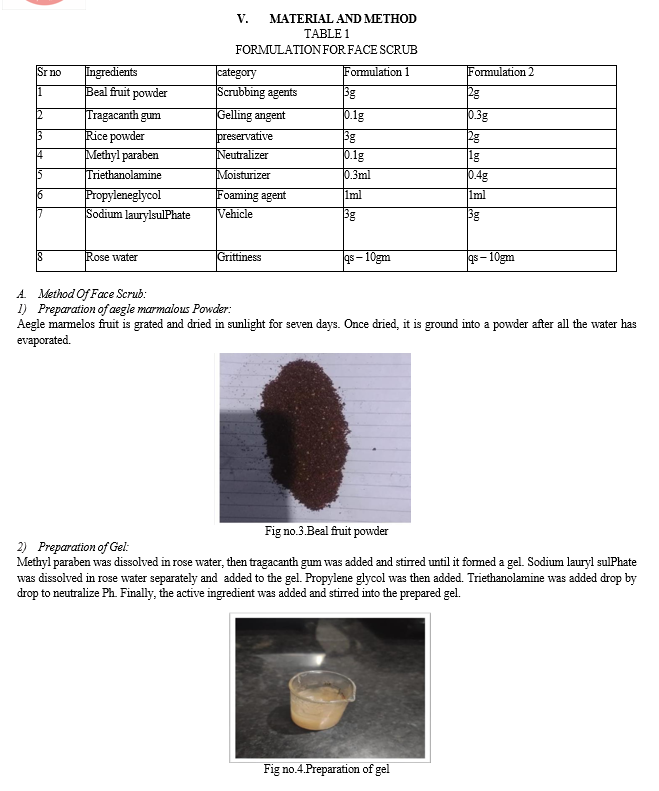
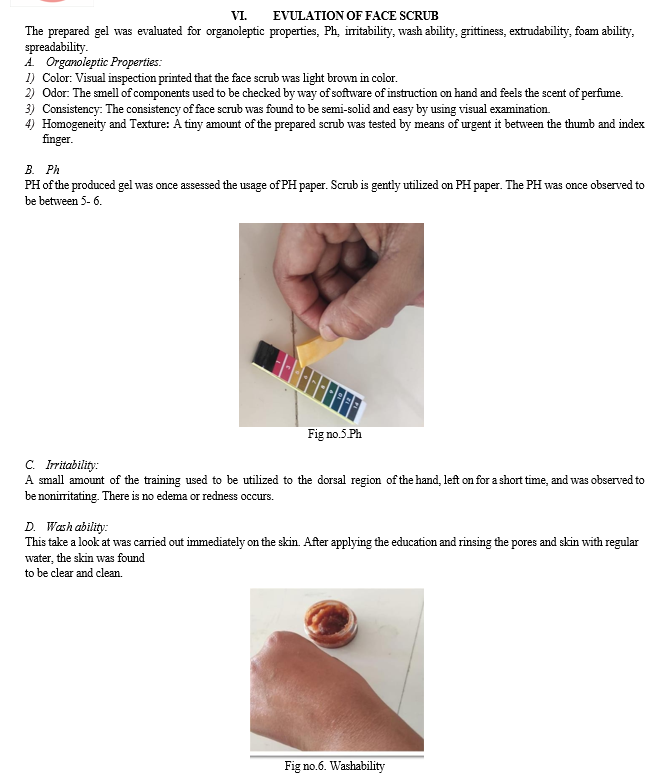
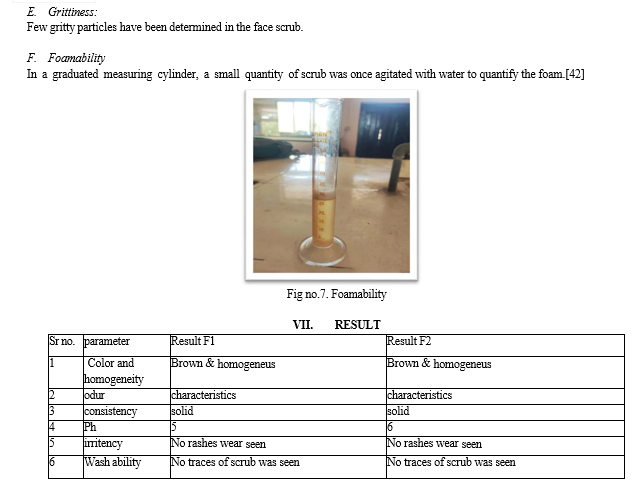
VIII. DISCUSSION
Evaluation parameter conducted on the scrub revealed significant findings. For instances, the scrub labelled as F2 exhibited a brown coloration, characteristic odur, and a solid consistency, Heras all formulations F1&F2 demostrsted good spredability and Ph level of 6.addtionally there waer no signs of irritancy observed for any of the formulation.
Conclusion
In this work, we tried to make a scrub. The created scrub gel used to be examined using a range of factors, and it was determined to Be fine for use on the skin to promote fitness and radiance barring causing any side effects. By incorporation of beal fruit powder as Scrubbing agent into the formulation, affectivity of product is increases. The use of a scrub enhances oxygenation of the skin’s surface. Skin feels softer, cleaner, and extra invigorated after making use of scrub. It can be used for any kind of pores and skin i.e. normal, oily, and dry. it gives pleasant end result and make the pores and skin top and healthy.
References
[1] Shoba rani R; Hire math. Text book of Industrial Pharmacy, Drug delivery systems & Cosmetics & Herbal drug technology: Universities press (India) Ltd; 2nd Edition. [2] Okeene JN, Udebuani AC, Elegy EU, and Basic KO, Nnoli MC. Possible Health Implications Associated with Cosmetics: A Review, Sci Public Health 2015; 3(5-1):58-63. [3] Mary P. Lupe. Antioxidants and Vitamins in Cosmetics. Dermatology 2001; 19:467–473 [4] p Gag, A., Agarwal, D. and Gag, Spreading of semisolid formulation. Pharm Tech. 2002; 9:89-105. [5] Harish N. M., Prabhakara Prather, and Subramanian E. V. S. Formulation and evaluation of in situ gels containing clotrimazole for oral candidiasis. Indian J Pharm Sci. 2009; 71(4):421-427. [6] Doberman D, Moharana PK, Mishra B, Ramana V and Dimple W. Clinical review of deep cleansing apricot scrub: a herbal formulation. International Journal of Bioassay. 4.9; 2015: 4251_4253. [7] Drawls Diana Cosmetic Dermatology: Products and Procedures, Wiley Blackwell Publishing Ltd. Chichestor; West Sussex, England 2016.2nd end: pp: 98. 8. Barman R and Mariachi Textbook of Cosmetic Dermatology, Taylor and Francis group. Abingdon; United Kingdom: 2005: 3rd end: pp.168. [8] Garb, A., Agarwal, D. and garb, S. 2002. Spreading of semisolid formulation. Pharm Tech, 9: 89-105. [9] Mahajan S, Gaya wad D, Tiwari A, and Darwhekar GN. 2020. Formulation and Evaluation of Herb-Mineral Facial Scrub. Journal of Drug Delivery and Therapeutics, 10(3): 195-7. gel, which promotes better blood waft and [10] Nguyen, T. 2014. Dermatology Procedures: Microdermabrasion and chemical peels. FP Essentials. 426: 16-23. [11] Showmanship SB, Kudale KS, Doles RT, Kotare KB. Www. ijrap. Net. [12] Nilani Packianathan, Rickman Kandasamy. 2011. Skin Care with Herbal Exfoliates, Functional Plant Science and Biotechnology. Global Science Book, 5(1): 94-97. [13] Algae SB, Gaye AU, Khurde A, Mehta D, Mohare T, Pangavane A, Kandalkar S. 2019. Preparation and evaluation of polyhedral facial scrub. Journal of Drug Delivery and Therapeutics, 9(2): 61-63. [14] Charlatan T. NE made, Nayana Baste Formulation and Evaluation of Herbal Facial Scrub, World Journal of Pharmaceutical Research, 2014 Vole 3 (3) 4367-4371. [15] Topeka, P. and Bourikas, M. 2016. Formulation, Development and Comparative Study of Facial Scrub Using Synthetic and Natural Exfoliate. Research Journal of Topical and Cosmetic Sciences, 7 (1): 1-8. [24] Gradate P. K, Mahamuni S. S. [16] Packianathan N, Kandasamy R: Skin care with herbal exfoliates. Functional Plant Science and Biotechnology 2011; 5(1):94-7. [17] Mahajan S, Gaya wads D, Tiwari A, and Darwhekar GN: Formulation and Evaluation of herb-Mineral Facial Scrub. Journal of Drug Delivery and Therapeutics 2020 May 15; 10(3):195-7 [18] Shiva and P, Nilam M, Viral D: Herbs play an important role in the field of cosmetics. International Journal of PharmTech Research 2010; 2, 632_9 [19] Gradate P. K, Mahamuni S. S, Kocher D. S. 2020. Formulation and Evaluation of herbal scrub using Tamarind peel. International Journal of Research, 9(7): 3-4 [20] Ashpak raPhik manner. 2022. A Review on formulation of polyhedral scrub. International Journal of Research Publication and Review, 3: 993 [21] https://blog.cintaaveda.edu/2014/11/the-history, [22] Badam L, Baedeker S, Son vane KB, Joshi SP. In vitro antiviral activity of bale (Aegle marvels Carr) upon human coxsackieviruses B1-B6. J. common. Dis. 34(2), 88 (2002). [PubMed] [Google Scholar] [23] Gupta AK, Tendon N. Reviews on Indian medicinal plants. Indian Council of Medical Research, New Delhi, India: 1, 312 (2004). [Google Scholar] [24] WWW.google.com. [25] Brijesh S, Dasani P, Tetali P, Anita N, Birdy T. Studies on the antidiarrheal activity of Aegle marvelous unripe fruit: validating its traditional usage. BMC Complement. Alters. Med. 9, 47 (2009). [PMC free article] [PubMed] [26] Kaur A, Kaila M. Physical chemical analysis of bale (Aegle marvelous) fruit pulp, seed and pericarp. Chem. Sci. Rev. Let’s. 6(22), 1213– 1218 (2017). [27] Basal S, Delgado R. Pharmacognosy fundamentals, applications and strategy. Academic Press, London, UK: (2016) [28] Boy HIA, Rutile AJH, Santos KA et al. Recommended medicinal plants as source of natural products: a Review. Digit. Chinese Med. 1(2), 131–142 (2018). [29] Maunders R, Bhattacharya S, Maunders A, Pattnaik AK, Tiwary PM, Chaudhary S. Antidiarrheal evaluation of Aegle marvelous (Correa) Linn. root extract. Phyther. Res. 20(1), 82–84 (2006). [PubMed] [30] Somlya Prakash Rout, Choudary KA, Karl DM, Das L, Jain A. Plants in traditional medicinal system - future source of new drugs. International J. Pharm. Pharm. Sci. 1(1), 1–23 (2009) [31] Baliga MS, Bhatt HP, JosePh N, Fatal F. Photochemistry and medicinal uses of the bale fruit (Aegle marvelous Correa): a concise review. Food Res. Int. [32] Kasseri AN, Gupta RK, Singh SK, Diwakar S, Withal G. Hypoglycemic and hyperglycemic activity of Aegle marvelous seed extract in normal and diabetic rats. J. EthnoPharmacol. 107(3), 374–379 (2006). [PubMed] [ [33] Nemkul CM, Bajracharya GB, Sheathe I. Phytochemical, antibacterial and DPPH free radical scavenging [34] Itchs Y, Ninomiya Y, Tajima S, Ishibashi A. Photodynamic therapy of acne vulgaris with topical delta-aminolaevulinic acid and incoherent light in Japanese patients. Br. J. Dermatol.144:575–579. [35] Premiumarticles.biz/beauty/why-should-you-use-face-scrubs-and-not- chemical scrubs.Pharmacognistical-3. [36] Dr. Jitendra patel .feb19, 2021 revives journal of honey [37] Oka N, Ikegami A, Ohki M, Sakata K, Yogi A, Watanabe N. Citronellyl disaccharide glycoside as an aroma precursor from rose flowers. Photochemistry. 1998; 47:1527–1529 [38] Buckle DR, Arch JRS, Boring NE, Foster KA, Taylor JF, Taylor SG, et al. Relaxation impact of potassium channel activators BRL 38227 and Pinacidil on guinea-pig and human airway clean muscle, and blockade of their results through Glibenclamide and BRL 31660. Pulm Pharmacology. 1993;6:77–86. [39] Dr. Jitendra patel .feb19, 2021 revives journal of honey . [40] Raymond. C. Rowe, Paul. J. Shaky, Marian. E. Quinn. 2009. Handbook of Pharmaceutical excipients. Pharmaceutical press, 6. [41] Sachin Bagwig Aglawe, Amol Uttamrao Gayle, Akash Khurde, Distant Mehta, Tushar Mohair, Ajinkay Pang vane, Saurabh Kandalkar. 2019. Preparation and evaluation of polyhedral facial scrub. Journal of drug delivery and therapeutics, 9(2): 61-63. [42] Mahajan Shraddha, Gaya wads Devshree, Tiwari Abhilasha, and Darwhekar G. N. 2020. Formulation and evaluation of herb-mineral facial scrub. Journal of drug delivery and therapeutics, 10(3): 196-197.
Copyright
Copyright © 2024 Anjali Chaudhari, Amit Chaudhari. This is an open access article distributed under the Creative Commons Attribution License, which permits unrestricted use, distribution, and reproduction in any medium, provided the original work is properly cited.

Download Paper
Paper Id : IJRASET61677
Publish Date : 2024-05-06
ISSN : 2321-9653
Publisher Name : IJRASET
DOI Link : Click Here
 Submit Paper Online
Submit Paper Online

